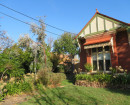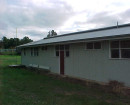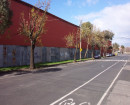STONE PIPE ORGAN THE AVENUE UNITING CHURCH
40-44 BLACKBURN ROAD BLACKBURN, WHITEHORSE CITY
-
Add to tour
You must log in to do that.
-
Share
-
Shortlist place
You must log in to do that.
- Download report


Statement of Significance
What is significant?
This organ was built by William Stone of St Kilda for the Congregational Church in St Kilda, and was officially opened on 20 March 1879. The old prefabricated iron church was sold in about 1888 and the organ was then moved into the new St John's Congregational Church in South St Kilda. William Stone played an important part in the growing organbuilding industry in Victoria. He was born c1830 in England and had undertaken an apprenticeship and worked in organbuilding in London before emigrating to Tasmania, where he established his own business. He arrived in Victoria in 1872 and opened a factory in Patterson Street, St Kilda in about 1875. By 1882 he employed his two sons and had built three organs, as well as having contracts for the tuning and repair of others. The organ was purchased for ₤1200 in 1973 by the congregation of The Avenue Presbyterian (now Uniting) Church in Blackburn, at the instigation of the church's organist Dr W Ralph. The church was designed by the Melbourne architect Keith Reid and built in 1959-60. The organ was restored and re-erected by members of the congregation under the direction of Dr Ralph. Laurie Pipe Organs were responsible for regulating the action and pipework. A recital was given in October 1979 to mark the centenary of the instrument.
The Stone pipe organ is installed in a gallery at the rear of The Avenue Uniting Church. It is a well-designed instrument with an attractive pine case, and exhibits a generous use of good materials and high quality workmanship. It is largely intact, retaining its original pipework, action, soundboards and windchest, console and case. All of the metal pipework is of spotted metal (a mixture of tin and lead) including the front pipes. The organ has an unusually bright and clear sound and is thus a fine example for the period. The builder's nameplate is attached above the keyboard. Work carried out in 1973 included stripping of dark varnish from the case timbers, the removal of gold paint, probably not original, from the front pipes, and the raising of wooden supports in the side towers to cover the pipe tops. It has two manuals, thirteen speaking stops, three couplers, and a mechanical action
How is it significant?
The Stone organ is of historical significance to the state of Victoria.
Why is it significant?
The Stone organ is historically significant as an outstanding example of colonial organbuilding, and demonstrates the growth and quality of the industry in Victoria in the second half of the nineteenth century. It is the only organ built by William Stone, who played an important part in the growing organbuilding industry in Victoria in the 1870s, which is known to survive intact. It exhibits an excellent overall design, a high quality of workmanship and has an unusually clear sound.
-
-
STONE PIPE ORGAN THE AVENUE UNITING CHURCH - History
CONTEXTUAL HISTORY
[From OHTA website, and E N Matthews, Colonial Organs and Organbuilders, Carlton 1969, p 26]
From the 1860s the indigenous organbuilding industry gained momentum at the hands of George Fincham (1828-1910). Developments mainly took place in Victoria, where a tariff gave protection to the craft; elsewhere in Australia the industry was slow to develop. From small beginnings, Fincham's firm prospered and by the end of the century had built almost 150 new organs for churches and public halls in four Australian states and New Zealand. Two other men played a part in the growing industry in Victoria, William Stone and Robert McKenzie.
Stone, born in England in about 1830, was not apprenticed to organbuilding as a lad, but was 'introduced to it simply as an amusement'. He was a contractor in London, where he later served his time at organbuilding. He migrated to Van Diemen's land, where he established his own business. He arrived in Victoria in 1872 and opened a factory in Patterson Street, St Kilda c1875. He was a small maker compared to Fincham's, who by 1882 employed eighteen men. By 1882 Stone employed only his two sons and had built only three organs, as well as having contracts for the tuning and repair of other organs. His two daughters were both doctors, the older one having been trained in Canada, and the other was one of the first two female medical graduates of the University of Melbourne.
HISTORY OF PLACE
[From the OHTA website]
This organ was built by William Stone, of St Kilda, for the Congregational Church, Alma Road, St Kilda, where it was opened on 20 March 1879 by P.C. Plaisted. This was a prefabricated iron church imported from England in 1855. It was sold in about 1888 and a new church, St John's Congregational Church, built in South St Kilda and the organ moved there. Following plans to demolish this church the organ was purchased in early 1973 by The Avenue Church congregation, at the instigation of its organist Dr W Ralph, for $1,200. It was moved to Blackburn, restored and re-erected by members of the congregation under the direction of Bill Ralph; Laurie Pipe Organs were responsible for regulating the action and pipework. The re-opening recital was given by Ted King on 5 August 1973.
This former Presbyterian Church was designed by the Melbourne architect Keith Reid. The foundation stone was laid in April 1959 and the building opened in February 1960. The Revd Fred Strickland, who was Minister of the church at the time, has stated that it followed the plan of St Columba's Presbyterian Church, Sale, which was designed by the same architect. In both instances, the choir was placed in a gallery at the rear of the church in order that it should sing with, rather than into, the congregation.
On Saturday 20 October 1979 a recital was held in the church to mark the one hundredth anniversary of the William Stone organ.
REFERENCES
OHTA website at http://www.ohta.org.au/
E N Matthews, Colonial Organs and Organbuilders, Carlton 1969.
STONE PIPE ORGAN THE AVENUE UNITING CHURCH - Assessment Against Criteria
a. The historical importance, association with or relationship to Victoria's history of the place or object
The Stone pipe organ is historically significant as an outstanding example of colonial organbuilding and demonstrates the growth of the organbuilding industry in Victoria in the second half of the nineteenth century.
b. The importance of a place or object in demonstrating rarity or uniqueness
This organ is the only organ built by William Stone, who played an important part in the growing organbuilding industry in Victoria in the 1870s, which is known to survive intact.
c. The place or object's potential to educate, illustrate or provide further scientific investigation in relation to Victoria's cultural heritage
d. The importance of a place or object in exhibiting the principal characteristics or the representative nature of a place or object as part of a class or type of places or objects
e. The importance of the place or object in exhibiting good design or aesthetic characteristics and/or in exhibiting a richness, diversity or unusual integration of features
The Stone pipe organ exhibits an excellent overall design, a high quality of workmanship and has an unusually clear sound.
f. The importance of the place or object in demonstrating or being associated with scientific or technical innovations or achievements
g. The importance of the place or object in demonstrating social or cultural associations
h. Any other matter which the Council deems relevant to the determination of cultural heritage significance
STONE PIPE ORGAN THE AVENUE UNITING CHURCH - Plaque Citation
The only surviving organ by William Stone, an important colonial organ builder, was built for the Congregational Church in St Kilda, in 1879. It was purchased for this church in 1973.
STONE PIPE ORGAN THE AVENUE UNITING CHURCH - Permit Exemptions
General Exemptions:General exemptions apply to all places and objects included in the Victorian Heritage Register (VHR). General exemptions have been designed to allow everyday activities, maintenance and changes to your property, which don’t harm its cultural heritage significance, to proceed without the need to obtain approvals under the Heritage Act 2017.Places of worship: In some circumstances, you can alter a place of worship to accommodate religious practices without a permit, but you must notify the Executive Director of Heritage Victoria before you start the works or activities at least 20 business days before the works or activities are to commence.Subdivision/consolidation: Permit exemptions exist for some subdivisions and consolidations. If the subdivision or consolidation is in accordance with a planning permit granted under Part 4 of the Planning and Environment Act 1987 and the application for the planning permit was referred to the Executive Director of Heritage Victoria as a determining referral authority, a permit is not required.Specific exemptions may also apply to your registered place or object. If applicable, these are listed below. Specific exemptions are tailored to the conservation and management needs of an individual registered place or object and set out works and activities that are exempt from the requirements of a permit. Specific exemptions prevail if they conflict with general exemptions. Find out more about heritage permit exemptions here.Specific Exemptions:General Conditions: 1. All exempted alterations are to be planned and carried out in a manner which prevents damage to the fabric of the registered place or object. General Conditions: 2. Should it become apparent during further inspection or the carrying out of works that original or previously hidden or inaccessible details of the place or object are revealed which relate to the significance of the place or object, then the exemption covering such works shall cease and Heritage Victoria shall be notified as soon as possible. General Conditions: 3. If there is a conservation policy and plan endorsed by the Executive Director, all works shall be in accordance with it. Note: The existence of a Conservation Management Plan or a Heritage Action Plan endorsed by the Executive Director, Heritage Victoria provides guidance for the management of the heritage values associated with the site. It may not be necessary to obtain a heritage permit for certain works specified in the management plan. General Conditions: 4. Nothing in this determination prevents the Executive Director from amending or rescinding all or any of the permit exemptions.Routine maintenance: Pipe Organs require regular servicing particularly tuning and attendance to action problems. Such procedures usually take place monthly, quarterly, half yearly or annually. Such activities would not impact in any way on the heritage status of the instrument provided they are carried out by appropriate firms, and would not require a permit.
STONE PIPE ORGAN THE AVENUE UNITING CHURCH - Permit Exemption Policy
All conservation, maintenance and repair works should be carried out in accordance with the standards outlined in the document produced by the NSW Heritage Office in consultation with the Organ Historical Trust of Australia, Pipe Organ Conservation and Maintenance Guide, specifically points numbered 1, 2 and 3. All other works require a permit. The preparation of a Conservation Management Plan is encouraged.
1. Cleaning and overhaul: This should ideally take place around every ten to fifteen years depending on the location of the organ. If pipework is removed from an organ for cleaning, it should never receive any revoicing or alteration.
2. Restoration: This work should always be carried out in association with an approved independent professional consultant who would develop a schedule for the work and nominate accredited organbuilders from whom quotations can be sought. The consultant can assist with the obtaining of relevant permits from Heritage Victoria, liaise with the custodian of the instrument (and Heritage Victoria) as the work proceeds, and sign off the work when it is completed according to the original schedule, write a report and authorize final payments. All work should conform with the Conservation and Maintenance Guide noted above.
3. Other work may be necessary from time to time, such as renewal of electric blowing plants, re-leathering of reservoirs, etc. Permits should be sought for such work to ensure that they comply with heritage standards.
4. Activities involving alteration to instruments (such as changes to action, pipework and case decoration) would, in most instances, fall outside what is permissible.
-
-
-
-
-
Various Elmore Houses
 National Trust
National Trust -
William Stone Organ (Uniting Church)
 National Trust
National Trust -
Blackburn War Memorial
 Vic. War Heritage Inventory
Vic. War Heritage Inventory
-
177 Fenwick Street
 Yarra City
Yarra City -
19 Cambridge Street
 Yarra City
Yarra City -
2 Derby Street
 Yarra City
Yarra City
-
-












